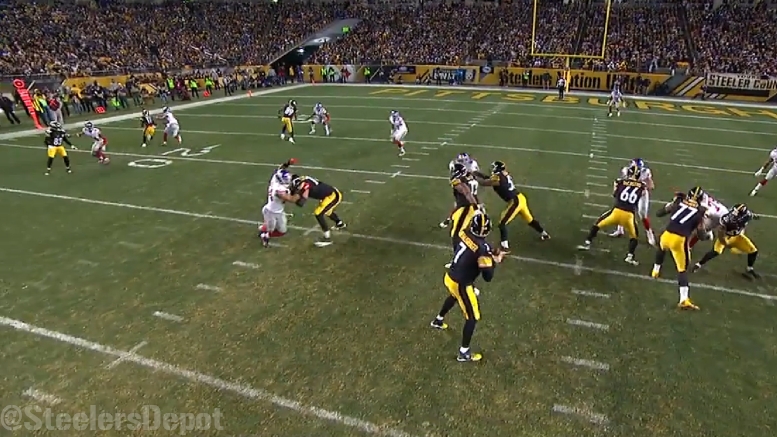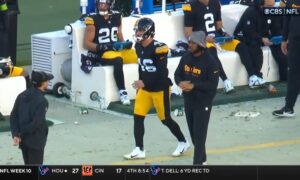The Pittsburgh Steelers won their third consecutive game on Sunday, and they found some notable success on offense in doing so, including having the first 100-yard rusher against the Giants’ defense this season. While they did not take full advantage of all of their opportunities—and the defense played its part—the balanced efforts of the offense, mixed with an explosive dynamic, gave New York trouble on the afternoon.
- Personnel formations:
- 11: 40/74 (54.1%)
- 12: 10/74 (13.5%)
- 13: 13 (17.6%)
- 21: 2/74 (2.7%)
- 22: 8/74 (10.8%)
- V-32: 1/74 (1.4%)
- While the Steelers did end up spending the majority of the game executing out of three-receiver sets, a good chunk of that could be attributed to their working a long drive late in the first half, which accounts for a decent chunk of that total.
- Once again, the team relied a lot on varied packages, though they didn’t use a fullback as much as might be expected. The reliance upon Chris Hubbard as an extra blocker the past several games has obviously played a role in the increase of looks from the 22, and especially the 13, personnel formations.
- About a third of the Steelers’ play-call selections from formations including fewer than three wide receivers were running plays, as would probably be expected.
- Something I’m interested in monitoring going forward is to see how often Ladarius Green plays lined up as a wide receiver in passing situations. By my count, he saw time on 27 passing plays, and he lined up as a wide receiver nine times, or 33 percent of the time. He also lined up as a receiver on one running play.
- I wonder if there is any correlation between Green’s inclusion in more passing situations and the reduction of snaps that Le’Veon Bell is seeing as a wide receiver. He lined up along the line only four times on Sunday, even though he played all but the final snap for a kneel down.
- The Steelers continue to barely use the no-huddle much at all, though they did use play-action on six of 41 passing situations, or close to 15 percent, which for them is actually high. Those snaps netted only two positive plays, but one was a 33-yarder to Green.
- It was a good day for yardage after the catch, as the Steelers recorded at least 10 yards after the catch on seven passing plays, or 17 percent. Three of those accounted for more than 20 yards. They picked up 167 yards after the catch overall, though they includes 24 yards of passes thrown behind the line of scrimmage.
- Average depth of target – 6.41
- Antonio Brown – 6.25 (8 targets)
- Cobi Hamilton – 4.33 (3 targets)
- Eli Rogers – 9 (4 targets)
- Le’Veon Bell – -1.71 (7 targets)
- Ladarius Green – 12 (11 targets)
- Jesse James – 7 (4 targets)
- David Johnson – -5 (1 target)
- It might seem a bit surprising at first that the average depth of target was pretty shallow, but the Giants focused a lot of their game plan on taking away the perimeter. There were 13 passes that traveled at least 10 yards, going 8 for 13 for 163 yards, two touchdowns, and an interception.








